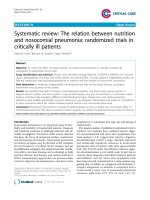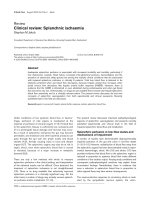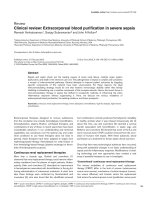Báo cáo y học: "Clinical review: The role of the intensive care physician in mass casualty incidents: planning, organisation, and leadership" pot
Bạn đang xem bản rút gọn của tài liệu. Xem và tải ngay bản đầy đủ của tài liệu tại đây (60.73 KB, 7 trang )
Page 1 of 7
(page number not for citation purposes)
Available online />Abstract
There is a long-standing, broad assumption that hospitals will ably
receive and efficiently provide comprehensive care to victims
following a mass casualty event. Unfortunately, the majority of
medical major incident plans are insufficiently focused on
strategies and procedures that extend beyond the pre-hospital and
early-hospital phases of care. Recent events underscore two
important lessons: (a) the role of intensive care specialists extends
well beyond the intensive care unit during such events, and (b)
non-intensive care hospital personnel must have the ability to
provide basic critical care. The bombing of the London transport
network, while highlighting some good practices in our major
incident planning, also exposed weaknesses already described by
others. Whilst this paper uses the events of the 7 July 2005 as its
point of reference, the lessons learned and the changes incorpor-
ated in our planning have generic applications to mass casualty
events. In the UK, the Department of Health convened an expert
symposium in June 2007 to identify lessons learned from 7 July
2005 and disseminate them for the benefit of the wider medical
community. The experiences of clinicians from critical care units in
London made a large contribution to this process and are
discussed in this paper.
Introduction
7 July 2005 witnessed the first suicide bombing on the UK
mainland, targeting the public in London. The multiple bomb
explosions on the London Underground and bus transport
system resulted in the biggest mass casualty incident in the
UK since the Second World War (52 dead and more than
700 injured). This was preceded by a similar attack in Madrid
in 2004 and followed by an attack in Mumbai in 2006, also
targeting transport infrastructure.
The Royal London Hospital (RLH) is a teaching hospital and
major trauma centre, with a 16-bed intensive care unit (ICU),
supplemented by a 6-bed surgical high-dependency unit
(HDU). On the day of the bombings, 194 casualties were
seen at the hospital, of whom 27 were admitted; 7 casualties
requiring ventilatory support were admitted to the ICU and
the remainder to the trauma ward and HDU. All of the
intensive care patients had been triaged directly to the
operating theatre to undergo major surgery, including limb
amputations, thoracotomy, laparotomy, and craniotomy. After
surgery, the patients were transferred to the ICU, from which
further assessments (including secondary and tertiary trauma
surveys) were organised. The bombing of the London
transport network, while highlighting some good practices in
our major incident planning, also exposed weaknesses
already described by others [1,2].
It seems clear to us, in reflecting on our response to the
events and the ensuing critical care requirements, that
intensivists should be intimately involved in disaster planning
and in the initial stages of the response to any major incident.
This paper, based in part on our participation with the UK
Department of Health expert symposium convened during
June 2007, will discuss how this might occur and at what
stages of these processes.
Intensive care medical response: 7 July 2005
Initial intensive care unit physician response
Five senior intensive care doctors were in the hospital at the
time the major incident was declared, and two more subse-
quently were able to attend. (Of this total, six were anaesthe-
tists and one a physician.) None of these senior medical staff
was notified via the paging system or mobile phone network
that a major incident was declared. Runners were more
effective in disseminating this information. As patients were
triaged to the theatre, there was ICU consultant and registrar
input in the resuscitation room and also in the operating
theatre complex. Although this separated the staff, it did
mean there was regular communication and early manage-
ment regarding the progress of patients who were ultimately
admitted to the ICU.
Review
Clinical review: The role of the intensive care physician in mass
casualty incidents: planning, organisation, and leadership
Peter J Shirley and Gerlinde Mandersloot
Royal London Hospital, Whitechapel, London, E1 1BB, UK
Corresponding author: Peter Shirley,
Published: 14 May 2008 Critical Care 2008, 12:214 (doi:10.1186/cc6876)
This article is online at />© 2008 BioMed Central Ltd
CCOT = critical care outreach team; HDU = high-dependency unit; ICU = intensive care unit; RLH = Royal London Hospital.
Page 2 of 7
(page number not for citation purposes)
Critical Care Vol 12 No 3 Shirley and Mandersloot
Intensive care unit command and control
The senior nursing office area in the ICU was set up as the ICU
coordination centre, with the ICU matron taking a lead
administrative role in organising and dispatching runners to get
updates, particularly from the operating theatre. A local
supermarket provided free food for the ICU staff during the
afternoon of 7 July. As the day progressed, one ICU registrar
was assigned as a dedicated clerk, working at a computer
terminal producing an updateable worksheet on each individual
patient with details of injury pattern, investigations, results, and
completed and planned surgery. This was the singularly most
useful effort and made the planning and organisation of
subsequent care for each patient more streamlined.
Intensive care unit patient flow through the hospital
Of the seven patients who were admitted to the ICU, all were
post-operative and sedated and ventilated, and their triage
had taken place in the resuscitation room by a senior
surgeon. As a result, no patient admitted to the ICU had fully
completed secondary surveys and several had missing
radiology. Three ventilated patients were identified as being
fit for transfer and were taken to other hospitals in Northeast
London with capacity expanded by the cancellation of major
elective surgical procedures. Four non-ventilated patients
were transferred to other hospital beds at the RLH. All HDU
beds except one were cleared and patients moved to ward
care. The five empty HDU beds were set up as emergency
ICU beds, with an additional four satellite beds set up in the
operating theatre recovery area. This work was done mainly
by the critical care outreach team (CCOT), but during the
event all of the intensive care patients were accommodated
within the physical space of the ICU.
All of these patients required ongoing critical care support for
an extended period of time (beyond the average ICU length
of stay) and all required repeated surgery. Over 180 hours of
additional theatre time were required over the following
3 weeks. Hospital length of stay was variable, and outpatient
follow-up for physical, as well as psychological, support is still
ongoing [3].
The successful outcome of the vast majority of patients
admitted to the RLH ICU on 7 July was multi-factorial and
included the relatively low number of seriously injured
casualties and the ability to contain them all within the ICU.
This enabled effective teamwork by clinicians from many
specialties who already had extensive experience dealing with
poly-trauma patients. At the time, however, this situation
generated many organisational and clinical learning points,
which have been incorporated into future training for medical
and nursing staff in the ICU, particularly in relation to flu
pandemic planning.
Most major incident planning concentrates on the first 6
hours, when most patients will not yet have reached the ICU.
There is little emphasis on the impact of this phase of care
from the ICU point of view or, in fact, on what is now termed
‘the prolonged-care phase’ following ICU admission.
The role of critical care in pre-incident
planning
Why should intensivists become involved in disaster
planning?
It may seem to some that events on a large scale are the
remit of someone else’s planning responsibility. Beyond
planning, many/most assume that the government and/or the
military will provide the necessary response capabilities.
These misconceptions can easily lead to three forms of
denial: (a) it will not happen here, (b) it will not happen to me,
or (c) someone else will take care of the problem.
Israeli physicians have shown that 4.7% of patients presen-
ting to the emergency department after terrorist bombings
require intensive care. In their experience, the greatest use of
ICU personnel and equipment occurs during the resuscitation
and resource allocation phases of the response to the
incident; their presumption is that around 70% of the patients
admitted to the ICU would require mechanical ventilation [4].
Often, while the initial emphasis is on expanding bed
capacity, scant attention is paid to the longer-term critical
care needs of these patients. Intensivists not only bring a
multi-disciplinary approach to planning, but also have the day-
to-day clinical experience in dealing with the sickest patients
in hospital [5]. In addition, this care is often delivered with
limited resources and stretched to capacity during ‘normal’
circumstances. Also, intensivists are able to predict where
and why bottlenecks in patient management would occur
since this is often a daily feature of their work. Finally, in the
event that insufficient facility ICU resources are available,
critical care will be provided in other non-ICU areas of the
hospital. Who will provide this care? How will it be
accomplished? What basic ICU skill sets should be taught to
other hospital personnel? Deliberate planning around these
issues must occur in hospitals and should be led by engaged
critical care professionals.
Why should intensivists be involved in disaster
planning, education, and training?
Disasters, whether natural or man-made, have always been
part of human existence. Current evidence continues to
support the threat of terrorism or of a man-made disaster
occurring. Most emergency planning at the governmental
level is on the basis of ‘when’ rather than ‘if’ and as such
hospital planning must reflect this outlook [6].
A major incident plan should be based on local and regional
facilities, incorporating experience gained from previous
incidents and planning exercises. Planning in isolated ‘silos’
(as opposed to a more broadly considered systems-based
approach) causes weaknesses that become all too apparent
in the subsequent execution of a disaster response. Co-
Page 3 of 7
(page number not for citation purposes)
ordination of care as well as interoperability among the
various work areas within the hospital will be hampered. And,
unfortunately, most existing planning processes do not
address necessary and essential critical care requirements.
Cooperation between designated receiving hospitals, neigh-
bouring hospitals (which may be in competition with each
other to provide local services), ambulance, police, and other
rescue services is essential to ensure a structured and co-
ordinated response. While it may seem difficult to plan at a
local level for ‘what may be’, there are some questions that
the intensivist must ask. Table 1 lists the questions we
consider most important as a starting point in assessing and
adapting our major incident planning.
We believe it essential that, in addition to involvement at the
local level, all intensivists be acquainted with disaster
response activation procedures as well as the roles and the
responsibilities of various levels of command and control
groups when disaster plans are activated.
Anaesthetists receive specific training in incident awareness
which extends beyond clinical content, including the non-
medical aspects of high-performance team behaviours.
Similarly, intensive care physicians should look upon their
unique role in the provision of major incident care as an
opportunity to develop the same skill sets [7].
A circumspect view of the initial response
Increasing capacity
Experience has shown that bed capacity is often the rate-
limiting step in caring for casualties [8]. This is especially true
for intensive care beds since these are often running at, or
close to, maximum capacity during normal daily hospital
operations. The ability to successfully and safely expand and
maintain surge capacity will depend on the following:
1. Type of disaster
2. Number of critically injured casualties
3. Duration of the casualty-generating circumstance
4. Available infrastructure (including staffing, equipment, and
drugs and other consumables)
5. Quantity and duration of the enhanced critical care
provision that is required.
On 7 July, there was an initial expectation to have to provide
intensive care to a large number of casualties and increasing
bed capacity was initiated with this in mind. In addition to the
transfer of stable longer-term patients to neighbouring
hospitals, patients on the ICU and surgical HDU who did not
require inotropic or invasive ventilatory support were trans-
ferred to general wards, their care supported by the CCOT.
The CCOT also supervised setting up a six-bed satellite ICU
in the HDU. In addition, one of the recovery rooms was
identified as a holding bay for patients prior to admission to
the operating theatres and could also be used as another
intensive care area. General ward areas were cleared and
patients discharged to the community under the care of the
primary health care system. Elective operating was sus-
pended at the RLH as well as two nearby hospitals.
Fortunately, the number of severely injured casualties
admitted to the hospital was limited and these facilities were
not required.
District general hospitals in our network area saw their
casualty attendance rise as non-incident-related casualties
diverted spontaneously. In the first hour after the bombings,
the hospital switchboard received 25,000 additional calls,
which rendered the internal phone system non-functional for
the remainder of the day. The mobile phone networks were
blocked at an early stage of the disaster to facilitate emer-
gency service communication. Flexibility was required to use
other resources (runners and internal email) to overcome the
loss of these contact facilities. During this phase, the ongoing
care of other (pre-event) critically ill patients required dedica-
ted staff provisions in order to prevent attention being
diverted exclusively to the disaster casualties.
The difficulty in planning was the uncertainty of when the flow
of seriously injured casualties would stop. It was noted in the
Madrid bombings of 2004 that the hospitals closest to the
incidents were quickly overwhelmed [9]. This was not
encountered in our situation, although more patients were
triaged to our location due to its identifiable association with
trauma management and the London Helicopter Emergency
Medical Service.
Much emphasis has been placed on the ‘command and
control physician’ in trauma resuscitation and this has been
shown to enhance the performance of the trauma team
[10,11]. In the intensive care setting, the intensivist should
act as the conduit for all information flow regarding patient
management decisions. This aspect of teamwork is liable to
be put under pressure in disaster scenarios, especially highly
emotionally charged situations, with the potential breakdown
of the normal decision-making hierarchy.
On the day of the bombings, the senior nurse in the ICU
became responsible for organising and dispatching runners
to get updates, particularly from the operating theatre. A
junior doctor was dedicated to compile work lists on a
database as each patient was admitted, listing injuries,
investigations, as well as current and planned treatment. This
made planning subsequent care for each patient much
clearer and smoother.
Multiple surgical teams were involved in patient care, and in
subsequent days we found that teams made decisions
without up-to-date knowledge regarding current patient
status. The root cause of this shortcoming was the location of
the handover meetings. We found it essential to centrally
locate these multi-disciplinary meetings in the ICU itself rather
than at a variety of distant locations.
Available online />Clinical triage
Of immediate concern on the day of the explosions was that
the hospital triage aligned patient needs with available
resources. If an explosive-type disaster yields low numbers of
critically injured patients, over-triage is likely to be a problem,
with the attendant risk of increasing overall mortality [12]. On
the day of the bombings, patients were triaged directly to the
operating theatre by a senior surgeon who assigned a
surgical ‘team’ (anaesthetist, surgeon, and operating depart-
ment practitioner) to each of the patients to follow them from
admission to the hospital through to the operating theatre
and ultimately delivery into the ICU.
One of the early problems encountered was the identification
of casualties. The standard triage system (casualty numbers
assigned at the scene) did not ‘dovetail’ with our hospital’s
existing patient numbering system. Assigning additional
hospital identifiers complicated cross-matching blood
products, obtaining laboratory results, and requesting
radiological imaging. The numbers assigned at the scene
were not site-specific and caused initial problems in
identifying victims. This experience is not unique and it has
been suggested that separate documentation in such
incidents be abandoned in favour of standard day-to-day
paperwork [13].
The concept of ‘damage control’ resuscitation and surgery is
not limited the operating theatre [14]. It is incumbent upon
the ICU physician to become involved in a patient’s care at
the earliest opportunity. This means a presence in the
resuscitation room. On the day of the bombings, there were
three ICU physicians present in the emergency department
who were directly involved in the resuscitation phase of the
most seriously injured casualties.
Critical Care Vol 12 No 3 Shirley and Mandersloot
Page 4 of 7
(page number not for citation purposes)
Table 1
Pre-planning action list for intensive care unit and mass casualty events
1. Logistics
Intensivist participates or is represented on the hospital major incident committee.
The major incident/disaster plan reflects the most likely events to be encountered, critical care elements are specifically addressed by the plan,
and the plan is easily accessible.
Plans are rehearsed and reviewed at regular intervals to reflect changes in circumstances and new evidence. Additional training for key staff is
required (clinical training as well as disaster response ‘mechanics’).
The plan contains provisions if decontamination and/or total intensive care unit (ICU) isolation becomes necessary.
Staging areas for staff, volunteers, and helpers are identified and practiced.
Are protocols in place for rationing (prioritisation) of ICU equipment if demand exceeds capacity (for example, mechanical ventilators)?
2. Communication
Up-to-date contact details are provided to all staff. Is this information easily accessible in an emergency?
Back-up communication systems when conventional systems are overwhelmed or fail are in place.
Liaison staff to deal with queries from relatives, the public, and media has been identified.
Links are established to inform local/regional back-up hospitals if we need help.
3. Capacity (including staffing)
How do we ensure that security (including checking of staff identity) is maintained?
Who is the lead intensivist and who is the senior nurse? Are their roles clearly defined?
What is the absolute limit in terms of increasing bed capacity? (This includes limits in terms of staffing.)
Transfer agreements with nearby intensive care units are in place.
How do we increase staffing, both clinical and non-clinical, and what is the fall-back position if this is not possible?
If the level of ICU care must be degraded because demand perniciously exceeds capacity, what is the plan to ensure that this occurs
decrementally with defined priorities (as opposed to haphazardly)?
4. Equipment
Inventory and servicing of equipment are up to date (including back-up equipment).
What are our levels of supplies of consumables, and how do we rapidly increase delivery when there is a sudden increase in demand? How
many supplies and doses of key medications do we have?
How do we cope with limitations in infrastructure (for example, power failure and communications failure)?
Ongoing care
While the casualty surge proved to be relatively brief and the
hospital resources were able to accommodate all patients in
a timely and appropriate fashion [12], this initial 24-hour burst
of activity was just the start of a prolonged-care phase that
greatly increased the surgical, anaesthetic, and intensive care
workload.
As soon as the emergency department was cleared of
casualties (within a few hours following the event), the major
incident response was stood down. Within 5 hours of the
start of the incident, the emergency department was re-
opened to major trauma casualties without necessarily
considering the potential impact on the operating theatres (all
working to maximal capacity). It is vitally important that these
sorts of decisions be communicated and acknowledged at
the managerial level and incorporated into the incident plan.
(The seven patients admitted to the ICU arrived hours after
the hospital major incident had been stood down.)
The haematology department at the RLH was one of the last
to be informed that a major incident had occurred; this was
identified as a weakness in the response to the incident at the
time. In Israel, reliable access to blood for transfusion as part
of the response to terrorist acts is seen as vital. This can
ensure the blood supply in times of disasters and minimise
outdating and wastage [15].
The timing of subsequent surgical intervention requires a
combined surgical, anaesthetic, and intensive care approach.
Recent evidence suggests that the inflammatory response to
multiple trauma can be exacerbated by surgery that extends
beyond the remit of damage control in the early stages [16].
To facilitate the number of complex admissions, we increased
the number of senior staff working the 24 hours, with a
rotational system of senior staff to spread the workload. It
proved difficult for all concerned to retain focus on the care of
the other ICU patients and we formally divided duties to
maintain consistent patient care to all.
Beyond the initial crisis, there is a need for longer-term
planning as recovery from critical care can take weeks and
months. Where extensive physical injuries are involved,
multiple surgical procedures often are followed by intensive
and sometimes prolonged rehabilitation. The lessons learned
in Australia and Israel can prove useful in guiding require-
ments in this phase of care [17,18].
Reflection and debriefing
The problems we faced following the events of July 2005
were not unique and are seen on an ongoing basis in other
parts of the world, including settings of insurgency warfare,
such as in Iraq and Afghanistan [19,20]. Even with a
comprehensive major incident plan and daily experience of
multi-trauma patient management, there still were some
obvious deficiencies in our system. The ethical dilemma of
‘non-clinical’ transfers is an uncomfortable aspect of
increasing capacity which needs to be considered and
agreed upon in advance. Not all of these were initially
apparent and it took more than 6 months to collate data. A
dedicated hospital-wide audit also brought the various teams
together to get a broad base of learning points. Intensive care
services have an important position in relation to these types
of casualties and our major incident plan had to be revised
and extended to include bioterrorism and infectious disease
strategies [21,22]. The detonations occurred in the relative
confines of underground train carriages and tunnels and in a
bus. The initial management focused on the basics of
intensive care, achieving optimal oxygenation and perfusion,
with a shift in individual patient management dependent on
the injury profile [23,24]. Bedside toxicology and chemical
agent monitors should be available in the ICU setting to
screen for the possibility of exposure. The extent of our
normal daily emergency workload as a major trauma receiving
centre, combined with a reasonable major incident plan and
the flexibility of all members of staff, were also major
contributory factors. The ability to provide best-practice care
without compromise probably contributed to our low mor-
tality. The long-term psychological impact of a terrorist act
should not be underestimated. Communication with psycho-
logical support staff at an early stage is essential to ensure
that patients, relatives, and staff can be advised of how to
access these services, should they be required [25].
Suggested next steps
A detailed risk assessment for specific crisis scenarios is
helpful, but trying to ‘best guess’ the next incident could
detract from robust flexible planning. Abortive terrorist attacks
in London and Glasgow in July 2007 have served to
emphasise the ongoing threat in the UK. Worldwide, ongoing
terrorist activities, natural disasters, and the threat of a flu
pandemic all serve to highlight the need for comprehensive
planning strategies. Each major incident plan is only as good
as the last time it was implemented. In crisis situations,
evidenced-based medical practice can all too easily be
replaced by panic, chaos, and emotionally based responses.
To minimise this, robust planning is of the essence and
intensivists should be involved in disaster planning at each
hospital level from admission to discharge.
Preparedness requires meticulous planning, extensive educa-
tion, and regular rehearsal and review if it is to be effective.
Even though major incident planning is recognised as a
priority for hospitals, many are still struggling to implement
changes to result in tangible improvements. Medical and
nursing staff can turn over at a high rate and because of this it
has been suggested that more standardisation between
hospitals in incident planning occur. It is also incumbent on all
staff to take the initiative to find out their unit’s major incident
plan and familiarise themselves with their indicated roles [26].
Many American hospitals, in light of events surrounding the
Available online />Page 5 of 7
(page number not for citation purposes)
attacks of 11 September 2001 and Hurricane Katrina in
2005, have issued very clear guidance in regard to the
‘commandments’ of major incident plans [27]. We feel it is
important that the ICU physician have a specific action card
within the hospital disaster plan, and at the RLH we are trying
to incorporate this into the major incident planning. Our
suggested example is shown in Table 2.
Conclusion
The provision of robust effective critical care along with ICU
functionality (efficiency) are vital parts of effective disaster
medical response. Lessons learned from the London
bombings by our hospital underscore the necessity of intensi-
vists in the planning as well as execution phases of disaster
medical response. We believe that these principles are
broadly applicable to all types of disasters.
Competing interests
The authors declare that they have no competing interests.
References
1. Lavery G, Horan E: Clinical review: communication and logis-
tics in the response to the 1998 terrorist bombing in Omagh,
Northern Ireland. Crit Care 2005, 9:401-408.
2. Hawryluck L, Lapinsky SE, Stewart TE: Clinical review: SARS -
lessons in disaster management. Crit Care 2005, 9:384-389.
3. Mohammed AB, Mann HA, Nawabi DH, Goodier DW, Ang SC:
Impact of London’s terrorist attacks on a major trauma centre
in London. Prehosp Disast Med 2006, 21:340-344.
4. Avidan V, Hersch M, Spira RM, Einav S, Goldberg S, Schecter W:
Civilian hospital response to a mass casualty event: the role
of the intensive care unit. J Trauma 2007, 62:1234-1239.
5. Roccaforte JD, Cushman JG: Disaster preparation and man-
agement for the intensive care unit. Curr Opin Crit Care 2002,
8:607-615.
6. Frykberg ER: Medical management of disasters and mass
casualties from terrorist bombings: how can we cope? J
Trauma 2002, 53:201-212.
7. Fletcher G, Flin R, McGeorge P, Glavin R, Maran N, Patey R:
Anaesthetists’ Non-Technical Skills (ANTS): evaluation of a
behavioural marker system. Br J Anaesth 2003, 90:580-588.
8. Johannigman JA: Disaster preparedness: it’s all about me. Crit
Care Med 2005, 33:S22-S28.
9. Gutierrez de Ceballos JP, Turégano Fuentes F, Perez Diaz D,
Sanz Sanchez M, Martin Llorente C, Guerrero Sanz JE: Casual-
ties treated at the closest hospital in the Madrid, March 11,
terrorist bombings. Crit Care Med 2005, 33:S107-S112.
10. Hoff WS, Reilly PM, Rotondo MF, DiGicomo CJ, Schwab WC:
The importance of the command physician in trauma resusci-
tation. J Trauma 1997, 43:772-777.
11. Thomas TL, Hsu EB, Kim HK, Colli S, Arana G, Green GB: The
incident command system in disasters: evaluation methods
for a hospital based exercise. Prehosp Disast Med 2005, 20:
14-23.
12. Aylwin CJ, Konig TC, Brennan NW, Shirley PJ, Davies G, Walsh
MS, Brohi K: Reducing critical mortality in urban mass casu-
alty incidents: analysis of triage, surge and resource use after
the London bombings on July 7, 2005. Lancet 2006, 368:2219-
2225.
13. Nocera A, Garner A: An Australian mass casualty incident
triage system for the future based upon triage mistakes of
the past: the homebush triage standard. Aust N Z J Surg
1999, 69:603-608.
14. Sagraves SG, Toschlog EA, Rotondo MF: Damage control
surgery—the intensivist’s role. J Intensive Care Med 2006, 21:
5-16.
15. Shinara E, Yahaloma V, Silverman BG: Meeting blood require-
ments following terrorist attacks: the Israeli experience. Curr
Opin Hematol 2006, 13:452-456.
16. Tschoeke SK, Hellmuth M, Hostmann A, Ertel W, Oberholzer A:
The early second hit in trauma management augments the
pro-inflammatory immune response to multiple injuries. J
Trauma 2007, 62:1396-1404.
17. Rosenfeld JV, Fitzgerald M, Kossmann T, Pearce A, Joseph A, Tan
G, Gardner M, Shapira S: Is the Australian hospital system
adequately prepared for terrorism? Med J Aust 2005, 183:
567-570.
18. Aschkenasy-Steuer G, Shamir M, Rivkind A, Mosheiff R, Shushan
Y, Rosenthal G, Mintz Y, Weissman C, Sprung CL, Weiss YG:
Critical Care Vol 12 No 3 Shirley and Mandersloot
Page 6 of 7
(page number not for citation purposes)
Table 2
Suggested action card for the intensive care unit physician
Action card – intensive care unit (ICU) physician
Initial actions
• Make contact with the incident medical director (emergency
department consultant).
• Check details of the incident.
• Assess the need for ICU beds and the timeframe.
• Liase with the senior ICU nurse and identify potential
increases in capacity.
• Liase with the senior anaesthetist and senior surgeon.
• Consider the level of response required and identify staffing.
• Establish the need for satellite ICU/high-dependency unit
beds or other beds.
• Ensure a sufficient number of runners to relay information on
patient movements.
• Establish an ICU control room with updates.
Clinical care
• Identify current patients suitable for transfer.
• Designate senior ICU medical representation for the
resuscitation room.
• Identify likely ICU patients and their dispersal (theatres,
computed tomography, or direct admissions).
• Ensure that care is not compromised in existing non-incident
ICU patients.
• In the event that resources are overwhelmed, liase with other
senior clinicians about the diverting of patients.
Post-incident
• Identify pitfalls in planning early and address them at the
earliest opportunity.
• Ensure the ongoing welfare and support of staff, patients, and
relatives.
This article is part of a review series on
Disaster management,
edited by
J Christopher Farmer.
Other articles in the series can be found online at
/>theme-series.asp?series=
CC_Disaster
Clinical review: The Israeli experience: conventional terrorism
and critical care. Crit Care 2005, 9:490-499.
19. Gawande A: Casualties of war—military care for the wounded
from Iraq and Afghanistan. N Engl J Med 2004, 351:2471-
2475.
20. Eiseman, B; Chandler JG: Military medical surge capacity in
times of war and natural disaster. J Trauma 2006, 60:237-239.
21. White SM: Chemical and biological weapons. Implications for
anaesthesia and intensive care. Br J Anaes 2002, 89:306-324.
22. Baker DJ: Critical care requirements after a mass toxic agent
release. Crit Care Med 2005, 33:S66-S74.
23. Levi L, Michaelson M, Admi H, Bregman D, Bar-Nahor R: National
strategy for mass casualty situations and its effects on the
hospital. Prehosp Disast Med 2002, 17:12-16.
24. Singer P, Cohen JD, Stein M: Conventional terrorism and criti-
cal care. Crit Care Med 2005, 33:S61-S65.
25. Wessely S: The London attacks—aftermath: Victimhood and
resilience. N Engl J Med 2005, 353:548-550.
26. Wong K, Turner PS, Boppana A, Nugent Z, Coltman T, Cosker
TD, Blagg SE: Preparation for the next major incident: are we
ready? Emerg Med J 2006, 23:709-712.
27. Lynn M, Daniel D, Memon A, Kaliff J: Management of conven-
tional mass casualty incidents: ten commandments for hospi-
tal planning. J Burn Care Res 2006, 27:649-658.
Available online />Page 7 of 7
(page number not for citation purposes)









